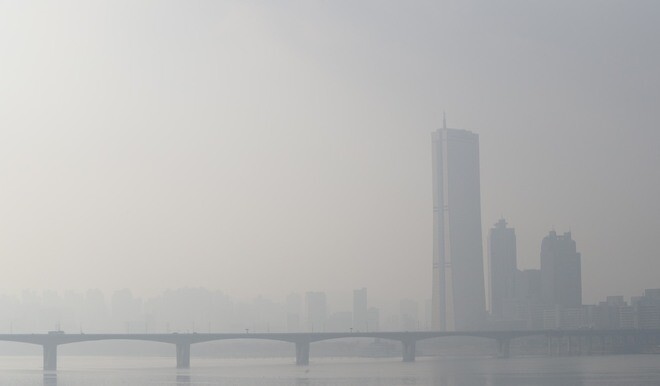hankyoreh
Links to other country sites 다른 나라 사이트 링크
Majority of fine-particle dust in S. Korea originates in China and overseas regions

Much of the fine particle dust in South Korea originates in China and other overseas regions, a big data analysis shows.
Fine dust concentrations in China were found to be high, with large concentrations on South Korea’s West (Yellow) Sea coast when westerlies are blowing. The analysis of fine dust causes was the first by the Ministry of the Interior and Safety (MOIS) using big data.
The MOIS-affiliated National Information Resources Service (NIRS) released findings on Jan. 28 from a data-based analysis of “Northeast Asian fine particle dust predictions and major factors” conducted with the UN Global Pulse Lab in Jakarta. According to the results, “unhealthy” air quality conditions were found to be associated with westerly winds and high concentrations of aerosols (tiny suspended particles in the air) in the Chinese regions of Shandong Province, Shanxi Province, Beijing, and Hebei Province.
A comparison of correlations for fine particle dust predictions at 20 Incheon-area observation sites showed the strongest connection for fine dust and nitrogen dioxide (NO2) in the Baengnyeong Island area rather than central Incheon. The figures were seen as evidence that the distribution of fine dust from the China region is relatively higher than from Incheon itself. When overseas factors were omitted from the analysis of Incheon fine dust data, the number of days when the air quality qualifies as “good” for the first quarter of 2018 was estimated to rise by 50% from 20 to 30.
To accurately analyze domestic and overseas factors, NIRS developed a fine dust prediction model for the Incheon area and assessed the major factors influencing dust concentrations. The data includes figures on fine dust and atmospheric pollution in the Incheon area between Jan. 2015 and March 2018, along with NASA satellite sensor data and aerosol observation data for Northeast Asia.
To improve the prediction accuracy of the analysis, the prediction model was based on gradient boosting (a machine-learning model to improve prediction accuracy) that showed optimal functioning for fine dust forecasting, NIRS explained. The resulting predictions for the first quarter of 2018 showed accuracy rates of 84.4% for fine dust (PM10) and 77.8% for ultra-fine dust (PM2.5) – around 15% more accurate that the current domestic fine dust forecasts. Major variables in Incheon fine dust predictions included satellite sensor data for Shandong, Shanxi, and Liaoning Provinces and Inner Mongolia in China, the standard deviation of wind direction, and wind speed.
To achieve even more accurate predictions, NIRS plans to acquire additional data from domestic geostationary satellites (Cheollian 2A and 2B), which boast outstanding aerosol analysis capabilities, to combine with different analytical models.
“This analysis is very significant both in terms of improving forecasting accuracy by actively applying a machine learning predictive model to fine dust forecasts, and in terms of being able to grasp the pathways through which fine dust arrives,” said NIRS director Kim Myung-hee.
By Lee Jung-ha, Incheon correspondent
Please direct comments or questions to [english@hani.co.kr]

Editorial・opinion
![[Column] Season 2 of special prosecutor probe may be coming to Korea soon [Column] Season 2 of special prosecutor probe may be coming to Korea soon](https://flexible.img.hani.co.kr/flexible/normal/500/300/imgdb/original/2024/0426/3317141030699447.jpg) [Column] Season 2 of special prosecutor probe may be coming to Korea soon
[Column] Season 2 of special prosecutor probe may be coming to Korea soon![[Column] Park Geun-hye déjà vu in Yoon Suk-yeol [Column] Park Geun-hye déjà vu in Yoon Suk-yeol](https://flexible.img.hani.co.kr/flexible/normal/500/300/imgdb/original/2024/0424/651713945113788.jpg) [Column] Park Geun-hye déjà vu in Yoon Suk-yeol
[Column] Park Geun-hye déjà vu in Yoon Suk-yeol- [Editorial] New weight of N. Korea’s nuclear threats makes dialogue all the more urgent
- [Guest essay] The real reason Korea’s new right wants to dub Rhee a founding father
- [Column] ‘Choson’: Is it time we start referring to N. Korea in its own terms?
- [Editorial] Japan’s rewriting of history with Korea has gone too far
- [Column] The president’s questionable capacity for dialogue
- [Column] Are chaebol firms just pizza pies for families to divvy up as they please?
- [Column] Has Korea, too, crossed the Rubicon on China?
- [Correspondent’s column] In Japan’s alliance with US, echoes of its past alliances with UK
Most viewed articles
- 1‘We must say no’: Seoul defense chief on Korean, USFK involvement in hypothetical Taiwan crisis
- 2N. Korean delegation’s trip to Iran shows how Pyongyang is leveraging ties with Moscow
- 3[Column] Season 2 of special prosecutor probe may be coming to Korea soon
- 4‘Weddingflation’ breaks the bank for Korean couples-to-be
- 5[Column] Has Korea, too, crossed the Rubicon on China?
- 6[Editorial] New weight of N. Korea’s nuclear threats makes dialogue all the more urgent
- 7[Reportage] On US campuses, student risk arrest as they call for divestment from Israel
- 8Korea sees more deaths than births for 52nd consecutive month in February
- 9[Column] Park Geun-hye déjà vu in Yoon Suk-yeol
- 10[Guest essay] The real reason Korea’s new right wants to dub Rhee a founding father